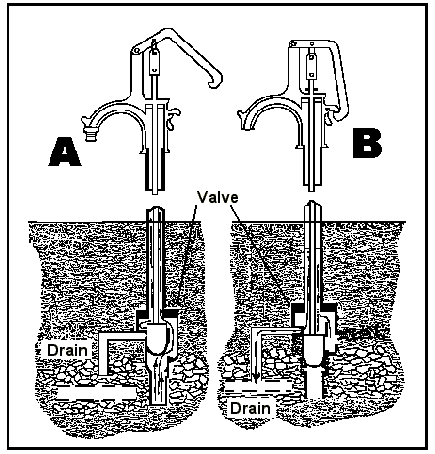Frost-proof (or freezeless) hydrants with stop and waste valves which, when turned off, drain back and discharge through subsurface outlets are not approved for use in public facilities. This policy relates to water distribution systems serving properties and commercial facilities under the jurisdiction of the State Department of Health.
The prohibition is incorporated by reference or specifically stated in Rules governing the construction and operation of campgrounds, agricultural labor camps, mobile home parks and other public or commercial facilities.
Stop and waste valves are an integral feature of many frost-proof and freezeless hydrants currently offered by manufacturers. The installation of such hydrants incorporating stop and waste valves draining back to gravel beds, hydrant boxes or drainage tiles cannot be approved or accepted.
Description Of Hazard
These hydrants are designed for use where freezing is a problem to allow year-round water service on private water supplies without the danger of damage to the pipes or hydrants.
The hydrants are connected to the water distribution system and possess a drain-back feature that allows the water standing in the column to drain below the frost line and discharge through a weep hole to a gravel bed or tile drain. When the water is turned on, the drain hole is automatically closed by a valve to allow water service (Figure A). When the hydrant is turned off, however, the valve opens the drain hole and permits the standing water in the hydrant column to escape through the drainpipe (Figure B).
The use of frost-proof hydrants incorporating this drain-back feature allows the possibility of back-siphonage of contaminated water into the water distribution system. This possibility can become a reality should a valve leak develop or a loss of pressure occur in the water distribution system.

Because the drain port is open when the hydrant is in the off position, it provides a convenient route through which impure groundwater, insects and dirt can enter the hydrant, thereby contaminating the water supply. Regardless of whether the hydrant is in the on or off position, contamination of the hydrant and water distribution system is possible under a variety of circumstances.
- First, the valve, which has the dual function of regulating both the water line inlet and the drain port, may leak or become poorly seated. This situation is particularly likely under prolonged use, following repairs, or when the valve rod is poorly adjusted. Mineral deposits and foreign materials or debris in the water may eventually cause the valve to seat poorly. Any valve of this nature, without regular inspection, may leak and is not equivalent to a complete physical break.
- Second, contaminated water or material in and around the hydrant drain can enter the hydrant and distribution system past the leaking valve. This can occur whenever pressure of the polluted source exceeds the pressure in the distribution system. Such back-siphonage or backflow can be produced by a variety of circumstances such as
- Shutting off a portion of the water distribution system and draining it for repairs;
- A break which drains portions of the piping system;
- Heavy demands, causing water to be drawn from higher elevations of the piping system;
- Too many outlets on an undersized piping system;
- Draining the pipelines for cleaning and flushing;
- Booster pumps that reduce inlet pressure below normal;
- Pressure due to blockage in a drainage tile to which the hydrant drain pipe is connected.
The probability of contamination of drinking water occurring through such a hydrant may seem remote; but, considering the number and use of such hydrants, the possibility is great. Such cross-connections through stop and waste valves, which make aspiration or backflow of contaminated water to the drinking water system possible, are an ever-present danger. Many documented cases of enteric illnesses have occurred through just such causes.
In addition, field inspection of facilities using such frost-proof hydrants have revealed the following:
- A greater than expected number of unsatisfactory bacteriological water samples from distribution systems;
- Observations of water leaking from the hydrant spout and valve rod entry indicating a leaking or poorly seated valve;
- Freezing of the hydrants during cold weather which would indicate a leaking valve or plugged drain.
Acceptable Options
- Where outside water service is not needed during winter weather, the distribution system should be designed and installed for ease of drainage prior to the onset of cold weather. Because stop and waste or drain-back valves are not acceptable, the system should be drained to grade at low points or compressed air used to clear the distribution lines.
- At properties where exterior water outlets are needed in cold weather it may be possible to use electric heat tape, immersion heaters, or an insulated housing for the water outlet to prevent freezing of the fixture.
- Acceptable frost-proof hydrants are available which utilize a reservoir built into the hydrant and set below the frost line. When the hydrant is turned off, the water in the hydrant barrel drains into the reservoir to prevent freezing.
When the hydrant is turned on, the water is evacuated from the reservoir by a piston or venturi ejector. Because no external drain is necessary, the possibility of contamination through back-siphonage is eliminated.
Additional information regarding specific manufacturers and models can be obtained from a local plumbing supplier.
Other manufacturers produce more conventional frost-proof hydrants incorporating an exterior drain but with a valve designed for installation on the drain pipe to prevent vermin access and back-siphonage. Because these valves cannot be visually inspected and their effectiveness in preventing backflow is questionable, they are not currently approved for installation.
All hydrants should be of the "threadless" type to prevent the attachment of hoses to the spout, or else be equipped with an atmospheric vacuum breaker to prevent the possibility of back-siphonage. - The installation of unapproved frost-proof hydrants utilizing an exterior drain cannot be accepted.
| Top |
